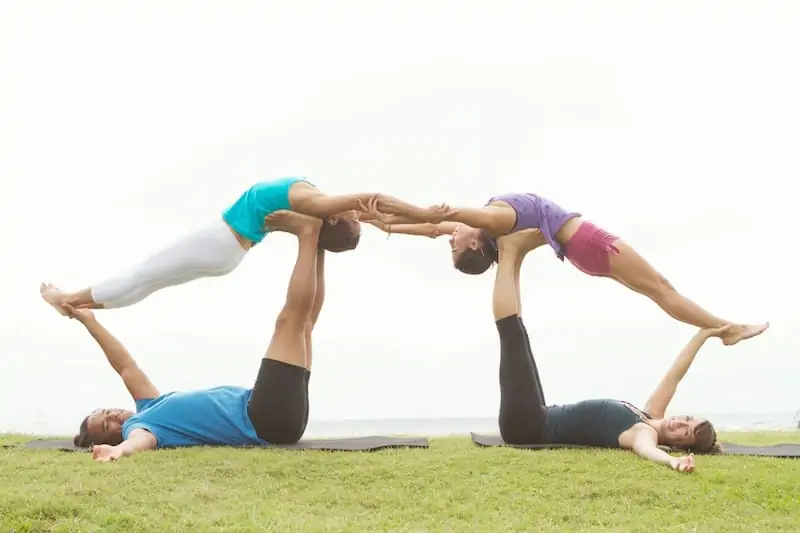Listen to this article:
Key Takeaway
Discover the joy and benefits of 4 person yoga poses, a playful blend of acrobatics and ancient yoga that enhances trust, communication, and physical health in a group setting.
Yoga is a deep internal practice; however, it doesn’t always have to be a solo quest. Acro yoga is a playful and invigorating practice that merges ancient yogic practices with teamwork acrobatics. Two, three, or even four people can work together to create artistic asanas that exercise the mind and body in a team setting. Acro yoga classes are widely available, and many poses are also simple enough to learn on your own with an online tutorial.
If you are looking for more community within the yoga world or just want to step out of your comfort zone into some collaborative gravity-defying experiments, grab a few of your friends to try out some of these four-person yoga poses.
Contents
What is Acro Yoga?
Acro yoga, or partner yoga, is a combination of yoga and acrobatics or gymnastics. It is a therapeutic or healing practice that is physically rejuvenating and also strengthens feelings of trust, unity, and collaboration between yoga partners.
Acroyoga is a relatively modern practice that combines the ancient wisdom of yoga with the creative, dynamic movements of acrobatic play between multiple people. You may associate acro yoga with couples or partner yoga, in which one person lies on their back while the other balances on their feet and performs various poses. However, acro yoga can also include several yogis and virtually endless variations of yoga asanas.
The result is an engaging, exhilarating, and pain-relieving practice with an abundance of benefits for your mind, body, and social connections. Not to mention, acro yoga makes for some fun photo ops.
Benefits of Group Acro Yoga
There is no better way to bond with your friends or family than by working together to achieve a challenge. Research has shown that social bonding increases exercise performance and that group movement leads to deeper social connections.
Improved Mental Health and Relationships
Group acro yoga is one of the most fun ways to build communication and trust while simultaneously improving your flexibility and balance skills. Acro yoga combines mental, physical, and respiratory exercises to sync breath and movement. The result is a sort of “flow state” where you are focused, present, relaxed, and inspired.
Just like solo yoga, acro yoga can drastically improve your mental health. The bonus is the socialization aspect, which strengthens your relationships with your yoga partners. When 2 or 4 people come together in a collaborative asana, they can strengthen their friendships and ability to be open with each other.
Better Communication and Conflict Resolution
Unlike the classic solo mat experience, acro yoga involves a lot of talking and communicating. The collaborative effort of a team yoga pose drastically improves how you communicate your needs and experience. There are also inevitable problems that arise when people make mistakes in certain asana positions.
This is an awesome opportunity to practice patience and conflict resolution between friends, partners, or family members. It’s often surprising how easily these experiences can transfer to improved communication off the mat. The joke goes, “People who do acro together, stay together.”

Back Pain Relief
On a physical level, group acro yoga lets you stretch your body in ways you couldn’t do on your own. For example, the classic Acro Bow Pose is a safe and rewarding inversion that offers incredible back pain relief. Another pose called “Super Yogi” gives therapeutic relief to the flyer’s spine and hips while stretching the base’s hamstrings.
Most classic acro yoga poses can be doubled up or modified to incorporate four people. If you’re wondering how the heck you get four yogis into an acro yoga pose without getting uncomfortably tangled together, you may be surprised by how easy (and fun!) these group asanas can be.
How do you do yoga poses with four people?

Yoga can be a quadrupled experience. There are many four-person yoga poses that combine multiple bases (bottom yogis who support the others), flyers (the yogis up in the air), and optional spotters (supporting team members).
While four-person yoga poses are not very common, they are certainly rising in popularity. As more families and friends take to social media with their exciting yoga challenges, the creative possibilities for acro poses continue to expand. Most poses are variations of two- or three-person partner yoga positions.
Despite the fascinating appearance of these team acrobatics, many poses are easier than they look. Anyone with moderate fitness, flexibility, and balance can do acro yoga.
Interestingly, the weight or size discrepancies between people don’t matter that much. Because these poses involve stacking the body weight of each yogi on the skeletomuscular structure of the base(s), the flyer can be significantly larger than the base and still accomplish the pose without injury. However, there’s no denying that acro yoga is easiest for individuals with similar body proportions or a stronger physique.
4 Person Yoga Poses Ideas

Acro yoga classes are becoming more and more popular in cities across the world, but not every studio offers training in this unique skill. Fortunately, you can learn many acrobatic poses through online tutorials. Here are a few of our favorites:
Before you dig into four-person poses, it helps to master the basics with two people. Koya Webb has one of the most approachable and simple videos to teach you how to enter, hold, and exit basic acro poses. These foundational moves are essential for progressing into any multi-person pose.
In this video with Chloe Knoerschild, a group of teenage girls demonstrate some fun 4-person yoga poses for yogis who are similar in size. These girls are close friends and ready to have plenty of fun and laughter as they figure out how to mimic photos of acro yoga poses. There is a youthful cheerleader vibe to these asanas.
As the friends show, there will be plenty of troubleshooting, giggling, squealing, and goofing off as you try to accomplish these team poses. If they can do it, so can you! Their experimental approach to copying photos from the internet is very playful and intuitive.
For the more fitness-minded yogis, this video from the Mastering Bodyweight Exercise channel demonstrates how a male base and three female flyers can accomplish some intermediate-level and advanced acro poses. From planking on top of balancing arms to standing on each other’s hips to holding themselves up with pure core strength, these 3 and 4-person poses are sure to be a good workout.
If you are gymnastically inclined or excel in your flexibility, this video is the one for you! These four-person poses are more advanced and require some background knowledge in cheerleading or gymnastics. They provide some fun inspiration for what we can work towards with our acro yoga partners!
How to Start Acro Yoga
Starting acro yoga is truly as simple as rolling out a few mats in a wide, open space and diving in. Be sure you have enough people to serve as spotters to keep beginners safe. Ideally, someone in your group should have enough knowledge of acro yoga to be able to lead you into more in-depth poses.
Make sure that the space is free of anything breakable or confining (because, trust me, there will be some not-so-graceful falls). Outdoor acro yoga in the grass tends to be the easiest way to start. However, if you can find an acro yoga class at a local studio, they will have extra space and equipment to help you get started in an indoor setting.
Most importantly, enter your practice with a light heart. Don’t be afraid to mess up and laugh at the awkwardness of trying something new. Acro yoga is about unleashing your inner child and having fun with people you enjoy!
Warm-Up Flows
Just like any fitness endeavor, you should always warm up before beginning acro yoga. Practicing some Vinyasa flows or Sun Salutations with your partner(s) will help loosen up tight muscles and prepare your mind for acrobatic fun. The more in sync you can get with your yoga partners, the easier it will be to pose together.
Get Comfortable with Your Yoga Partners
While it is not physical in any way, acro yoga is an intimate experience that requires getting comfortable with touching and supporting other people’s bodies. Warming up to each other’s energy is equally as important as warming up the body. Acro yoga is a great way to bond with new yogi friends or even with strangers as long as you openly communicate throughout the practice.

To get comfortable with your acro yoga partners, start with simple partner poses like back-to-back chair poses or cooperative stretches. Do a few rounds of pranayama breathing together to center yourselves and sync your breath. It also helps to know each other’s names, experience level, and any past injuries or sensitivities that need to be looked out for.
Practice Basic Flying
The easiest acro poses to start with involve just two people, with a base laying flat on their back and a flyer that will balance on their feet. The base bends their knees and places the bottoms of their feet comfortably above the hips of the flyer. Then, the flyer leans into the feet and reaches for the base’s stretched-out hands.

Together, they slowly straighten their legs and bring the flyer straight above the base. From here, there are lots of possibilities to experiment with. Practice these basics before trying out 3- or 4-person poses.
Get Creative with the Group
Once you’ve got the foundational floating yoga poses down, you’re ready to bring in some group creativity. A stacked plank, a double-jointed reclined boat pose, or a simple downward dog train are all incredibly fun opportunities to dive in with four people.

These poses will open up your mind to new possibilities for how you can modify other asanas to include the whole team. Remember to check in regularly with the bases to be sure that they are comfortable and safe as they support added weight from more flyers. It also helps to have a fifth-person spotter to help everyone stay in alignment and balance.
Closing Thoughts
Modern yoga is not just a single or partner experience; in fact, it can include a whole family or group of friends! Four-person yoga poses are more accessible to the average yogi than they appear. Once you master the basics of balancing and engaging your core in partner yoga poses, the possibilities for quadrupled yogi experiments open up a whole world of creativity, laughter, and an awesome workout.
Have you ever tried a four-person yoga challenge? We’d love to hear about it!
Namaste!






